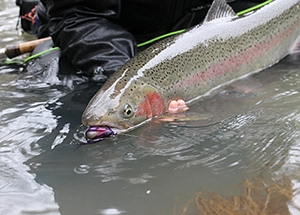
Catch-and-release: Tips to reduce fish mortality
In some Oregon state waters catch-and-release fishing is required in order to protect valuable fish resources. One way anglers can help maintain and restore native fish populations is to learn how to catch and release wild fish properly.

Whether it's a personal choice or a regulatory requirement, catch-and-release of wild fish is one way Oregon anglers can help maintain and restore native fish populations, particularly where their populations are threatened, and to learn how to do it properly.
Check the regulations before you fish. Consult the Oregon Sport Fishing Regulations for any harvest restrictions.
Land the fish quickly. A fish on the end of the line is under stress, so don't play the fish to utter exhaustion. Severe exhaustion reduces the fish’s odds of surviving.
Support the fish when bringing it in. Support the fish underwater in a natural position, handling it as little as possible. Give it time to recover and keep it in the water, it needs all the oxygen it can get from the water passing over its gills.
Use barbless hooks. Bring the fish quickly within reach. Leave the fish in the water and, without squeezing it, remove the hook carefully with long-nosed pliers or thumb and forefinger. If necessary, cut the leader near the hook, which will dissolve over time.
Revive the fish before releasing. Point the fish into the current or in standing water, gently move the fish forward until its gills are moving and it maintains its balance on its own. Let the fish swim freely from your hands.
Use appropriate gear. Use tackle, including line and rod, that are strong enough to bring your fish in quickly and gently.
Getting a photograph
Taking a photograph with your fish can be a lovely way to capture the moment. But try to minimize handling and keep the fish in the water as much as possible with these tips:
- Have help. If someone is helping you with the photo, make sure they’ve composed the shot and adjusted the camera settings before you remove the fish from the water.
- Get your hands wet before handling the fish. This will help protect the delicate membrane on fish’s skin.
- Support the fish properly. Put one hand under the forward part of its body and the other at the base of its tail. Keep the fish in the water.
- When you’re ready, cradle the fish at or just above water level and snap a quick picture.
- Return the fish to the water quickly. Then revive it gently before letting it swim away.


